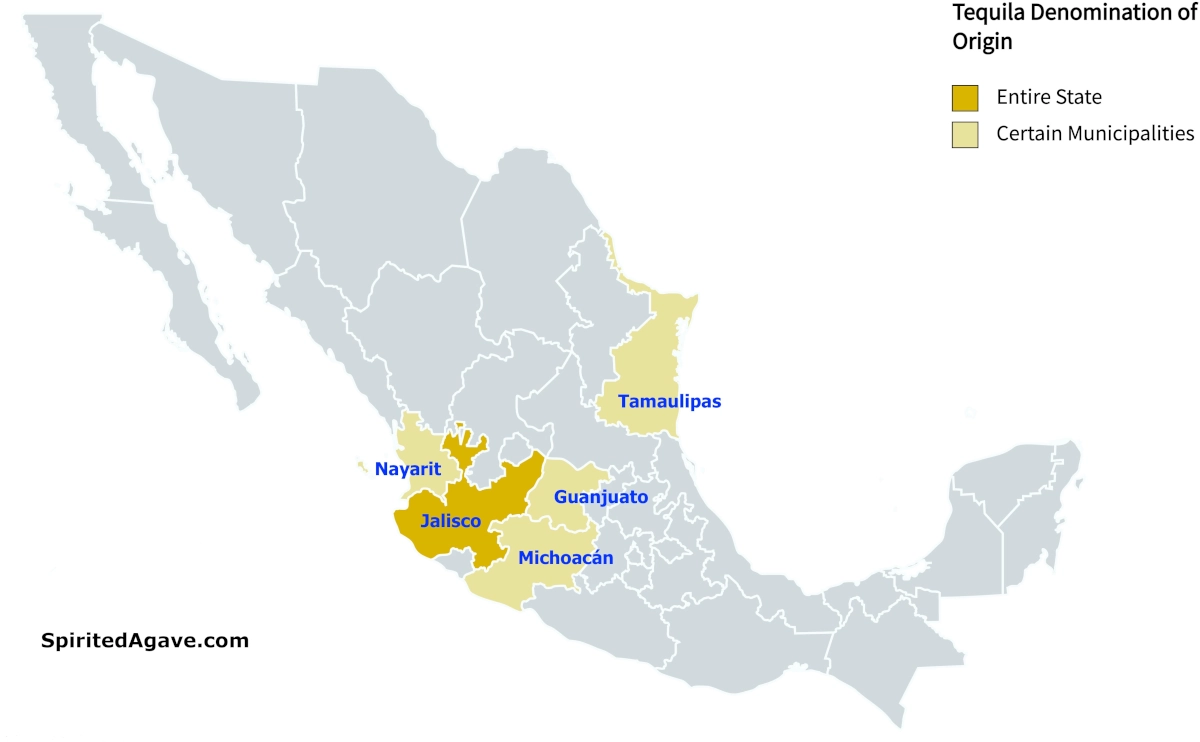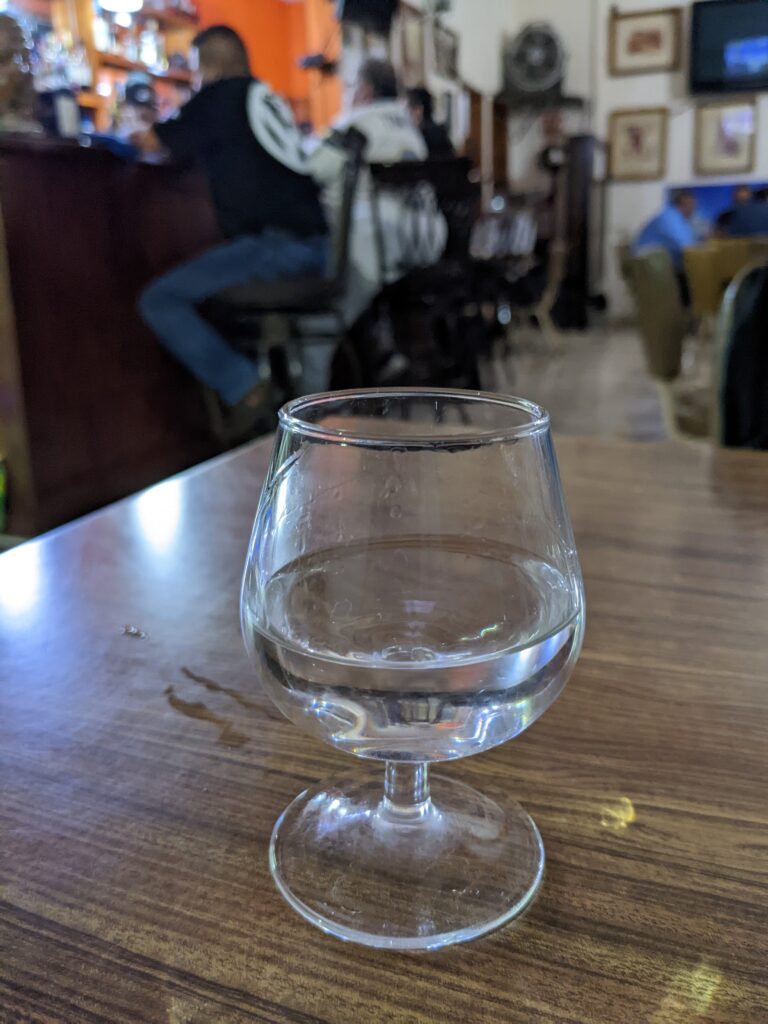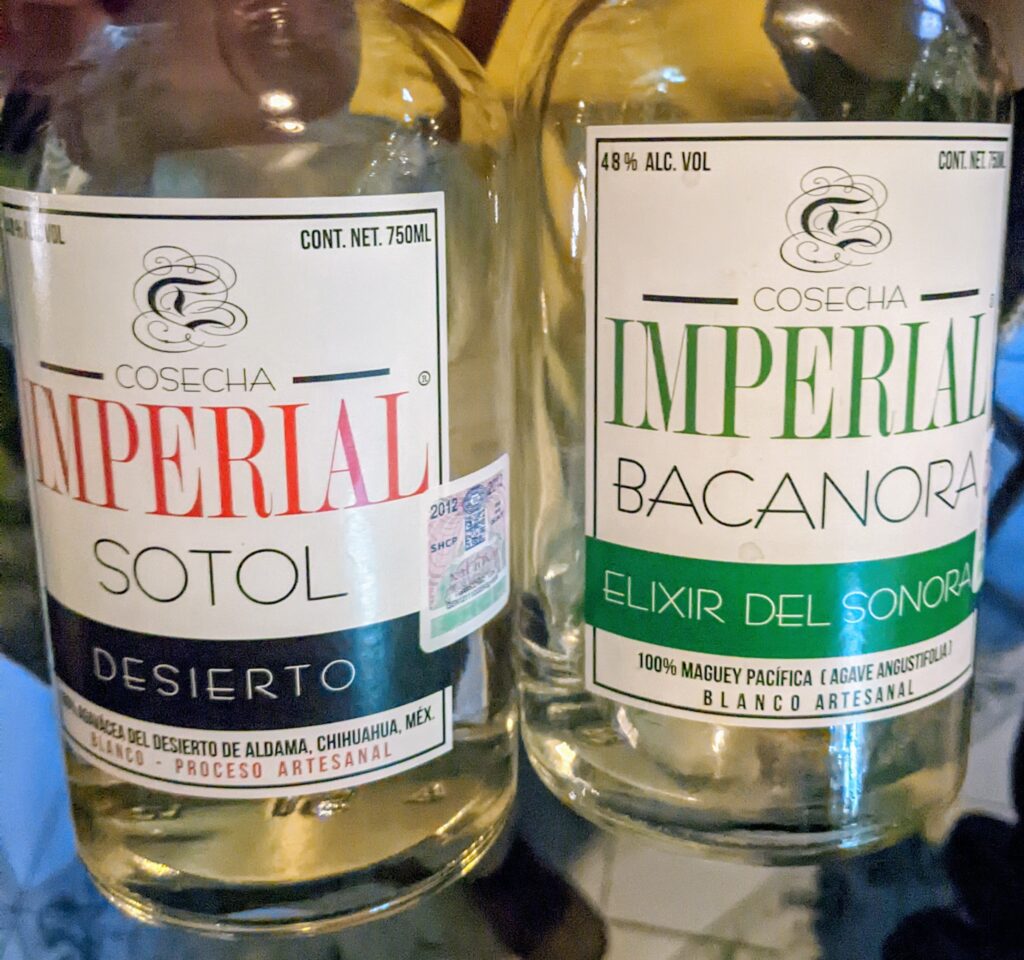Tequila is a distilled spirit made from the blue agave plant (agave tequilana) which is produced according to specific rules and in specific areas in Mexico. It is a subcategory of agave spirits known as mezcal. Tequila can be sipped, taken as a shot or mixed in many popular cocktails such as the margarita and tequila sunrise.
Tequila dates back to at least the 1600s when distillation was introduced to the Americas. It has been officially classified by the Mexican government since 1974. Under these rules tequila can only be produced in the state of Jalisco and in limited parts of four other states: Michoacán, Guanajuato, Tamaulipas and Nayarit. In reality, about 90 percent of tequila comes from Jalisco.

Table of Contents
Types of tequila

The five main types of tequila are blanco, oro, reposado, añejo and extra añejo. The varieties apart from blanco are aged in oak barrels and tend to take on a golden color. Cristalino tequila is a relatively new treatment that filters aged tequila through activated charcoal which removes all color.
- Blanco (AKA “plato” or “silver”)
- Unaged tequila or aged for up to 2 months in oak barrels
- Oro (AKA “gold” or “joven”)
- A blend of blanco and other aged tequila
- Reposado (AKA “aged”)
- Tequila aged between 2-12 months in oak barrels
- Añejo (AKA “extra aged”)
- Tequila aged 1-3 years in oak barrels
- Extra añejo (AKA “ultra aged”)
- Tequila aged more than 3 years in oak barrels
- Cristalino (not yet an official classification)
- Aged tequila filtered through activated charcoal which removes all color
Tequila can be either 100% from agave, which will be labeled as such, or produced using a mix of up to 49% other sugars such as from sugarcane and labeled simply as tequila. Tequila containing other sugars is also known as a mixto. Each of the main types of tequila can either be 100% agave or a mixto, although more premium brands are typically 100% agave.
Many other drinks also contain tequila and may be marketed as liqueurs, flavored tequilas or ready to drink cocktails. Pink, or rosa tequila made by aging in red wine barrels is a rising trend but does not have its own classification.
Learn more about blanco vs reposado tequila, and what’s best for different types of drinks.
Tequila history
As a product of agave, tequila traces its roots back to well before the Spanish arrived in Mexico to the indigenous drink now known as pulque. Pulque is the fermented sap from the core of the agave and was often associated with spiritual and sacred use.
With the Spanish arrival in the late 1500s the process of distillation was introduced. Although distilled pulque does not have such an appealing taste, it was discovered that cooking the piña (the core of the agave) prior to fermentation produced a much more agreeable flavor. Thus vino de mezcal was born. The word mezcal comes from the indigenous Nahuatl word mexcalli meaning oven baked agave. So vino de mezcal means “wine from oven baked agave”.
The area around the town of Tequila in the state of Jalisco was known to produce particularly good vino de mezcal, which became known as vino de tequila and in turn simply tequila. The first commercially licensed tequila production was in 1795 by the family of José Cuervo. The Jose Cuervo brand continues today as by far the largest selling tequila worldwide. Cenobio Sauza, founder of Sauza Tequila was the first to export tequila to the United States in 1873.
The official classification for tequila with its rules around location and method of production has been in place since 1974. The organization responsible for regulation is the Consejo Regulador del Tequila (CRT, or the Tequila Regulatory Council). The rules are known as the Norma Oficial Mexicana (NOM). Each certified distiller is issued a unique NOM number which is printed on each bottle of tequila.
Tequila production
Tequila is made from the cooked and fermented sap of the blue Weber agave (a specific variety of the blue agave), and is then further distilled. The agave is most commonly farmed and can take five to nine years before it is mature and ready for tequila production. The entire plant is harvested but only the sap rich core or piña is used. The piña is first cooked and then fermented before being distilled. The steam cooking typically takes place in a brick oven, a pressurized autoclave, or a modern diffuser which is a more industrialized technique. The cooked piñas are then shredded and added to fermentation vats for between three to 10 days depending on the weather. Wild or cultured yeast is added to help the process. For tequila which is not 100% agave, cane or brown sugar is added during fermentation.
Water is usually added to dilute to around 40% alcohol and it can then be bottled or aged in French or American oak barrels between two months to three years or more. The aging process imparts color, softens the taste and adds other flavoring elements often resulting in a more balanced and approachable product.
Under the regulations four types of additives can be introduced without disclosure for aged tequilas even if it says 100% agave on the bottle. The permitted additives are caramel coloring, sugar syrups, glycerine and oak extract. In theory these elements are allowed so as to create a smoother taste and more appealing color. It is commonly reported that there is a 1% total additive limit, however under the regulations up to 1% of each of these additives may be included1.
Tequila versus mezcal
Tequila tastes different to mezcal primarily due to its production process: the piñas are generally cooked through steam for tequila, whereas for mezcal they are typically baked in underground ovens, which adds smokiness.
Secondly, tequila is made from just one species and variety of agave (blue Weber) whereas mezcal can technically be made from any of the hundreds of species of agave (including blue Weber). Each species and variety will have its own taste profile meaning the spectrum of flavors is much wider with mezcal than tequila.
The production processes used to make tequila are typically far more industrialized which produces a more consistent product. Small scale mezcal production leads to variation between batches which can be as small as 150 bottles or less. By contrast, super premium tequila label Casa Dragones is known as a small batch producer with batches up to 6000 bottles. Large tequila brands will typically use cultured yeasts to ensure consistency in fermentation, whereas smaller scale mezcal producers generally use wild yeasts, introducing further variation.
Most tequilas are bottled at 40% ABV whereas the ABV for mezcal is often higher, particularly for more artisanal brands.
Lastly, mezcal is produced in a much wider variety of locations across Mexico compared to tequila. This leads to differences in the environmental factors that affect agave growth and character, known as terroir.
Serving tequila

Despite its reputation as a shot-based drink, in Mexican cantinas you are likely to find tequila served neat in a small brandy-style glass for sipping. Sometimes a small glass of sangrita is served alongside blanco tequilas. Sangrita is a zingy tomato based drink usually containing citrus and chili.
Going back hundreds of years, glasses were in short supply and tequila was sometimes served from a bull’s horn.
Not surprisingly, Mexican’s are the highest consumers of tequila per capita. But perhaps unexpectedly, Latvians are the number two consumers. Americans sit in third place per capita, but the USA is the largest market for tequila overall.
Outside of Mexico it has been custom to lick salt off your hand, take a shot of tequila, and then bite into a lime wedge in quick succession. With the growing availability of higher quality tequilas outside of Mexico it is becoming more common to sip tequila, or in some cases mix with water and/or ice.
There is an official tequila glass made by Austrian stemware company Riedel, with a shape similar to a narrow wine glass.
Tasting different tequilas with a similar theme, for example different age expressions from the same producer, is called a tequila flight. There are many variations possible which make it a great way to learn more about tequila.
Tequila has long been served in cocktails. The most popular being the margarita, which also contains lime juice and an orange based liqueur such as triple sec, and is served over ice or blended together with the ice. Dozens of variations of the margarita exist including those with sweetener added, in particular agave syrup or nectar. The International Bartenders Association maintains an Official List of Cocktails, with tequila featuring in five.
Nutritional features
Tequila is often claimed as being nutritionally friendly for a range of dietary backgrounds. The claimed health benefits extend to those with diabetes, those concerned with blood sugar levels and bone density, and those keeping specific diets such as vegan, kosher, paleo or keto. Tequila is also gluten free.
Many of the supposed health advantages are linked to properties found in the agave plant which do not survive the distillation process. Being an alcoholic product there are a host of potential dangers from overconsumption. However, in moderation tequila may be a healthier alternative (or even just less harmful) to other common forms of alcohol.
As with many distilled spirits, additive-free tequila is sugar free and has zero carbohydrates. This is because the natural sugars in the agave plant have been converted to alcohol. Although tequila has no carbs, common mixers of course may.
As noted above, some tequilas may contain undisclosed additives including up to 1 percent sugar. Blanco tequilas are the only type where additives are not permitted, so if you want to ensure what you are drinking is sugar free, then choose one of these.
By regulation tequila contains between 35 and 55 percent alcohol content (70 to 110 proof). Under United States regulations, all spirits sold must be at least 40 percent alcohol content (80 proof) and this is the most common level for mass market brands. In Mexico, the same brands are often bottled and sold at 35 percent or 38 percent (70 or 76 proof).
A standard 1.5 ounce shot of tequila at 40 percent alcohol has 97 calories. This is equivalent to 406 kilojoules in a 44 ml shot. While additive free tequila contains no sugar, carbs or fats, alcohol itself contains 7 calories per gram.
Brands behind tequila
Tequila has recently been the fastest growing liquor category and new brands are springing up every day. The highest selling tequila brand by far is Jose Cuervo, which also happens to be the oldest. Behind that is Bacardi-owned Patrón then Don Julio, Casamigos (both owned by Diageo) and the Beam Suntory-owned Hornitos rounds out the top five. Around 80% of sales are made by the top 10 tequila selling companies.
Celebrity owned tequilas continue to make headlines. George Clooney was one of the earlier participants who famously sold his Casamigos brand to Diageo for US$1 billion.
Others to enter the tequila game include Michael Jordan (Cincoro), AC/DC (Thunderstruck), Kendall Jenner (818), The Chainsmokers (JAJA), Rita Ora (Próspero), Nick Jonas and John Varvatos (Villa One), Adam Levine and Behati Prinsloo (Calirosa), Dwayne “The Rock” Johnson (Teremana), Mark Wahlberg (Flecha Azul) and Eva Longoria (Casa Del Sol).
If you’re wondering where Bryan Cranston and Aaron Paul’s tequila is, you’re close, the Breaking Bad pair launched a mezcal brand, Dos Hombres.
Along with the growth in the tequila industry there has been an explosion in tequila marketed as “super premium” with as much attention seemingly paid to the bottle as what’s inside. Clase Azul’s blue and white bottle with the bell on top is instantly recognizable from across the bar or club. Many of Clase Azul’s releases are in the top most expensive tequilas in the world.
Related drinks

Mexico also produces a range of other agave based drinks including the spirits raicilla and bacanora. There are also agave spirits which do not officially meet the rules to be classified in another category which are known more broadly as “agave spirits”, “destilados de agave” or “aguardiente de agave”. Pulque is a fermented drink made from agave sap. Sotol is made in a similar way to mezcal but comes from the desert spoon plant which is not an agave.
Agave based spirits are also produced outside of Mexico, including in Australia, USA, South Africa, Peru, Venezuela and India.
Footnotes
- https://internationaltequilaacademy.com/tequila-additives-complete-guide-2020/
